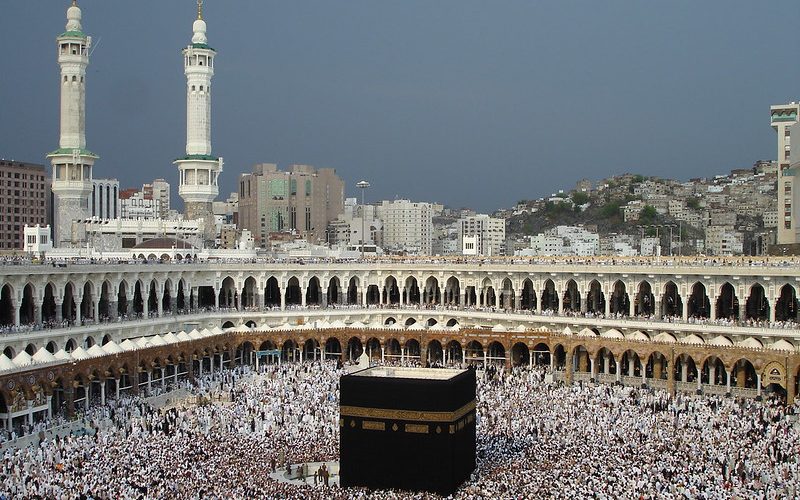At first, the developments of seventh-century Arabia seem disruptive. It may appear that the events’ progression seldom fit what we now call the period of Late Antiquity. According to sources of Islamic tradition, there was a man we now know as Muhammad. He established a community to believe in ‘One God and the Day of Reckoning’. Early Christian sources describe him as a monotheist preacher and military leader1. Under the pressure of persecution from the tribal status quo, he migrates (hijra) to safety, expands his influence, propagates his monotheist message, and conquerors his opponents or persuades them to join his cause2. Muhammad’s campaign eventually gained traction and spread across Arabia, even after his death. The old empires of Iran and the eastern provinces of the Byzantine empire succumb to the Muslims. Under the rule of the Muslims, new cities emerged, and sacred buildings, (mosques) were erected. Muhammad’s message was placed on a pedestal to be revered and followed. Muslim sources from this period further strengthened the disassociation of the emergence of Islam by mostly describing disagreement and combat within Muslim factions, the glorification of people occupying high positions, and battles with vague enemies who challenged their power externally. The significant elements of Late Antiquity are reduced to mere taxpayers and infrequent rebellions3.
The question arises then, whether Islam’s emergence can be situated in the context of Late Antiquity. To better understand this, this article evaluates the emergence of Islam in the context of developments in Late Antiquity. I argue that Arabia was a significant part of the Late Antiquity from which Islam emerged. Contrary to traditional sources, I will argue that what eventually became the Islamic civilisation was a continuation of Late Antiquity’s most salient features, with late antique empires establishing the foundations for the initial development of Islam. Moreover, my argument also focuses on the role played by traditional sources in instigating academic curiosity and mistrust from revisionist scholars who challenged the traditionalist premise entirely.
Although the period of Late Antiquity emphasises the notion of continuity, the time before the advent of Islam was one of enormous transition and turmoil. Due to their fragile territorial control, the Roman and Persian empires were replaced by the ecumenical Byzantine and Sasanian empires4. Due to their proximity to one another, conflict was inevitable. Both these empires instituted extensive cultural, social and political developments to the expense of local autonomy in Byzantium and the provincial aristocracy in Sasanian Iran. Both advanced towards absolutist and centralist rule. On top of that, the ruling elite was no longer apathetic to the masses and their beliefs. Rulers from both empires developed an interest in promoting religious uniformity by interfering in religious disputes among their people5.
Hence, the relationship between power and religion is strong during Late Antiquity. One good example is Christianity. Constantine the Great’s conversion ensured a strong relationship. On the other hand, Judaism convinced the ruling class on multiple occasions, most notably during the Himyarite dynasty of Southern Arabia, which persecuted Christians during the 6th century6. When seen in this context, early Islam situates itself during the period of Late Antiquity in many ways. Not only did Muhammad serve as a legislator and preacher for the Muslim population in Medina, but he was also the military commander and religious judge. Individuals who succeeded him, who eventually headed the nascent Muslim community to conquer the majority of the Arabian Peninsula, were known as ‘commanders of the believers’ and ‘deputy of God'7.
Submit here
It is important to note that during the period of Late Antiquity, emperors actively infused the concept of religion with the opportunity of acquiring more land for them to rule. This is one of the reasons why Constantine was attracted to Christianity. The aspect of universalism established Christianity as an appropriate instrument for Constantine to rule. The emperor assumed the role of God’s representative over all people and the responsibility to spread the message of God throughout the world through military campaigns. When all of this is considered, it is clear that Islam did not end Late Antiquity, at least not in its early stages. Instead, it maintained its most distinguishing features. During its nascent phase, the Muslim empire moved quickly to carry out the objectives of late antique emperors such as Khosrow II, Justinian, and others to expand their influence. The architecture and position of the Dome of the Rock on the Temple Mount in Jerusalem and its writings made a strong visual statement that Islam is the only true religion. During the reign of Abd al-Malik, he criticised the Jews and Christians for their weak monotheistic beliefs. It is evident that the Dome of the Rock was not merely a monument for Muslims but intended for Christians and Jews8. The integration of political power with religious authority was, therefore, not disruptive to the emergence of Islam. Empires before Islam, as mentioned before, practised it to expand their influence and territory. In a sense, Islam fulfilled a dynamic of Late Antiquity by continuing and harmonising politico-religious universalism.
Although the historical period now referred to as “Late Antiquity” is a modern historiographical construct, Fowden proposes a new way of understanding periodisation that challenges the Brownian concept of Late Antiquity and dismisses elements of European ethnocentrism. According to his alternative periodisation, which he refers to as the “First Millennium,” Islam concludes an epistemic tradition in terms of rational, legalistic, and monotheistic aspects, which Islam does not create but indeed appropriates, continues, and strengthens9. Even when alternative periodisations are considered, the disruptive nature of Islam miraculously emerging in the Middle East is an incoherent idea.
The traditional approach carefully contrasts the arrival of Islam with the background of Jahiliyya. This was a time when Arabia was involved in all forms of idolatry, adultery, polytheism, warfare, infanticide, and superstition10. The concept of straying from the right path is emphasised during this period. According to a traditional Muslim narrative, the Qur’an and Muhammad usher in an entirely new era, one that dismisses everything that came before it, one that develops its own beliefs and notions, and one that does not require or pay attention to external influence. Thus, there are two ways to conceptualise Islam’s emergence and development: a religio-political movement formed in the world of Late Antiquity. Or, a movement developed outside the world of Late Antiquity and only introduced itself to the world after it matured. The ‘outside of Arabia’ point of view is the traditional approach. However, the ’emerged in Late Antiquity’ viewpoint is gaining traction among scholars11.
The traditional approach has been criticised for discounting historical understanding and presenting it unidimensionally. Several Western historians argue that there are several historical accounts of Muhammad and his followers that are developed many years after his death; this late summation of oral history not only transforms the chain of transmission but also distorts important events and facts that are carefully amended to reflect an entirely different picture12. As a result, early Islamic studies have been divided into two schools of thought: traditionalists, who acknowledge the depiction of Islam’s disruptive emergence in Arabia and revisionists, who deny it13.
The depiction of Jahiliyya as a background to the emergence of Islam has warranted criticism from scholars of Late Antiquity. Archaeological evidence presented by Christian Robin, a scholar of pre-Islamic Arabia, paints a different picture of the pre-Islamic Hijaz. Robin argues that contrary to traditional accounts of Jahiliyya, pre-Islamic Hijaz was not isolated, remote or cut off from the world of Late Antiquity. Expanding Himyar’s authority and influence into Arabia’s northern and central regions implies that the Hijaz was not immune to isolation. Moreover, it also contradicts the conventional perception of the Jahiliyya, establishing the traditional perception ahistorical14. Consequently, several Western Islamic scholars, particularly Patricia Crone, developed a sense of uncertainty about early Islamic sources and ironically used those very sources to claim that early Muslims were unaware of, if not wholly ignorant, of the ‘characteristics of Late Antiquity’15. Therefore, it can be argued that traditional sources which depict the emergence of ‘Islam’ as disruptive paved the way for scholars to argue otherwise.
It is apparent from the evidence presented that Islam did not miraculously emerge and elements of the religion, before it solidified as a religio-political movement, were present before its conception. Moreover, the traditional periodisation of the Jahiliyya forces us to acknowledge the historiographical motivation for painting Islam as a disruptive yet unique idea emerging in seventh-century Arabia. Therefore, it is not completely incorrect to state that the Islamic civilisation was neither a cause nor a result of Late Antiquity but rather its most successful crystallisation, with late antique empires creating the prerequisites for its development and emergence.
Sources Cook, Michael. Muhammad. Oxford University Press, 1983. //global.oup.com/ushe/product/muhammad-9780192876058. Crone, Patricia, and Martin Hinds. God’s Caliph: Religious Authority in the First Centuries of Islam. University of Cambridge Oriental Publications. Cambridge [Cambridgeshire]: Cambridge University Press, 1986. http://catdir.loc.gov/catdir/toc/cam032/85026992.html. Dijkstra, Jitse, and Greg Fisher. ‘Interactions between Rome and the Peoples on the Arabian and Egyptian Frontiers in Late Antiquity’. In Inside and out: Interactions between Rome and the Peoples on the Arabian and Egyptian Frontiers in Late Antiquity: Recent Epigraphic Discoveries and Latest Advances, 3rd ed., 33–82. Late Antique History and Religion 8. Leuven: Peeters, 2014. Dodgeon, Michael H., Samuel N. C. Lieu, and Geoffrey Greatrex. The Roman Eastern Frontier and the Persian Wars: AD 363-630 : A Narrative Sourcebook. London: Routledge, 1991. Fowden, Garth. ‘A NEW PERIODIZATION’: In Before and After Muhammad, 49–91. The First Millennium Refocused. Princeton University Press, 2014. http://www.jstor.org/stable/j.ctt5hhnh9.7. Hawting, G. R. The Idea of Idolatry and the Emergence of Islam: From Polemic to History. Cambridge Studies in Islamic Civilization. Cambridge: Cambridge University Press, 1999. https://doi.org/10.1017/CBO9780511497490. Howard-Johnston, James, and Averil Cameron. ‘The Two Great Powers in Late Antiquity’: In The Byzantine and Early Islamic Near East, 157–226. Volume 3: States, Resources and Armies. Gerlach Press, 2021. https://doi.org/10.2307/j.ctv1b9f5rq.10. Hoyland, Robert G. ‘The Earliest Christian Writings on Muḥammad: An Appraisal’, 276–97. Leiden, The Netherlands: Brill, 2000. https://doi.org/10.1163/9789004452909_012. Humphreys, R. Stephen. ‘THE SOURCES’: In Islamic History, 25–66. A Framework for Inquiry – Revised Edition. Princeton University Press, 1991. https://doi.org/10.2307/j.ctv10h9dc9.6. J., Koren, and Nevo Y.D. ‘Methodological Approaches to Islamic Studies’. Der Islam: Journal of the History and Culture of the Middle East 68, no. 1 (1991): 87–125. https://doi.org/10.1515/islm.1991.68.1.87. Johnson, Scott Fitzgerald, ed. The Oxford Handbook of Late Antiquity. Oxford University Press, 2012. https://doi.org/10.1093/oxfordhb/9780195336931.001.0001. Raby, Julian. Bayt Al-Maqdis (Part One): ’Abd al-Malik’s Jerusalem and Bayt Al-Maqdis (Part Two): Jerusalem and Early Islam (Oxford Studies in Islamic Art IX, Parts One and Two, 2 Volumes) by Julian Raby; Jeremy Johns (Eds.): New Hardcover (1992) 1st Edition | Islamic Art Books. Edited by Jeremy Johns. London, United Kingdom: Oxford University Press, 1992. https://www.abebooks.co.uk/first-edition/Bayt-Al-Maqdis-Part-Abd-al-Maliks-Jerusalem/30935217648/bd. Robin, Christian Julien. ‘Le judaïsme de Ḥimyar’. Arabia, no. 1 (2003): 97–172. Robinson, Chase F. ‘Reconstructing Early Islam: Truth and Consequences’. In Method and Theory in the Study of Islamic Origins, 101–34. Leiden, The Netherlands: Brill, 2003. https://doi.org/10.1163/9789047401575_009.
Footnotes
- Robert G. Hoyland, ‘The Earliest Christian Writings on Muḥammad: An Appraisal’ (Leiden, The Netherlands: Brill, 2000), 276–97, https://doi.org/10.1163/9789004452909_012. [>]
- Michael Cook, Muhammad (Oxford University Press, 1983), //global.oup.com/ushe/product/muhammad-9780192876058. [>]
- Chase F. Robinson, ‘Reconstructing Early Islam: Truth and Consequences’, in Method and Theory in the Study of Islamic Origins (Leiden, The Netherlands: Brill, 2003), 101–34, https://doi.org/10.1163/9789047401575_009. [>]
- James Howard-Johnston and Averil Cameron, ‘The Two Great Powers in Late Antiquity’:, in The Byzantine and Early Islamic Near East, Volume 3: States, Resources and Armies (Gerlach Press, 2021), 157–226, https://doi.org/10.2307/j.ctv1b9f5rq.10. [>]
- Michael H. Dodgeon, Samuel N. C. Lieu, and Geoffrey Greatrex, The Roman Eastern Frontier and the Persian Wars: AD 363-630 : A Narrative Sourcebook (London: Routledge, 1991). [>]
- Christian Julien Robin, ‘Le judaïsme de Ḥimyar’, Arabia, no. 1 (2003): 97–172. [>]
- Patricia Crone and Martin Hinds, God’s Caliph: Religious Authority in the First Centuries of Islam, University of Cambridge Oriental Publications (Cambridge [Cambridgeshire]: Cambridge University Press, 1986), http://catdir.loc.gov/catdir/toc/cam032/85026992.html. [>]
- Julian Raby, Bayt Al-Maqdis (Part One): ’Abd al-Malik’s Jerusalem and Bayt Al-Maqdis (Part Two): Jerusalem and Early Islam (Oxford Studies in Islamic Art IX, Parts One and Two, 2 Volumes) by Julian Raby; Jeremy Johns (Eds.): New Hardcover (1992) 1st Edition | Islamic Art Books, ed. Jeremy Johns (London, United Kingdom: Oxford University Press, 1992), https://www.abebooks.co.uk/first-edition/Bayt-Al-Maqdis-Part-Abd-al-Maliks-Jerusalem/30935217648/bd. [>]
- Garth Fowden, ‘A NEW PERIODIZATION’:, in Before and After Muhammad, The First Millennium Refocused (Princeton University Press, 2014), 49–91, http://www.jstor.org/stable/j.ctt5hhnh9.7. [>]
- G. R. Hawting, The Idea of Idolatry and the Emergence of Islam: From Polemic to History, Cambridge Studies in Islamic Civilization (Cambridge: Cambridge University Press, 1999), https://doi.org/10.1017/CBO9780511497490. [>]
- Scott Fitzgerald Johnson, ed., The Oxford Handbook of Late Antiquity (Oxford University Press, 2012), https://doi.org/10.1093/oxfordhb/9780195336931.001.0001. [>]
- R. Stephen Humphreys, ‘THE SOURCES’:, in Islamic History, A Framework for Inquiry – Revised Edition (Princeton University Press, 1991), 25–66, https://doi.org/10.2307/j.ctv10h9dc9.6. [>]
- Koren J. and Nevo Y.D, ‘Methodological Approaches to Islamic Studies’, Der Islam: Journal of the History and Culture of the Middle East 68, no. 1 (1991): 87–125, https://doi.org/10.1515/islm.1991.68.1.87. [>]
- Jitse Dijkstra and Greg Fisher, ‘Interactions between Rome and the Peoples on the Arabian and Egyptian Frontiers in Late Antiquity’, in Inside and out: Interactions between Rome and the Peoples on the Arabian and Egyptian Frontiers in Late Antiquity: Recent Epigraphic Discoveries and Latest Advances, 3rd ed., Late Antique History and Religion 8 (Leuven: Peeters, 2014), 33–82. [>]
- Johnson, The Oxford Handbook of Late Antiquity. 1054 [>]








Be First to Comment